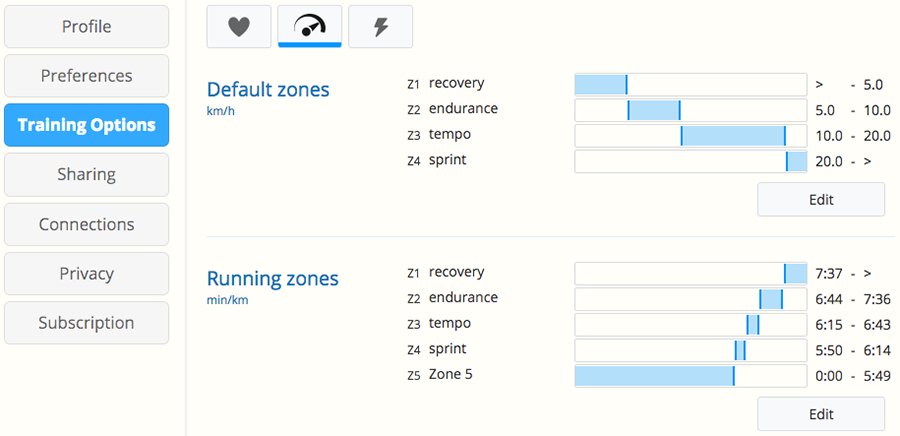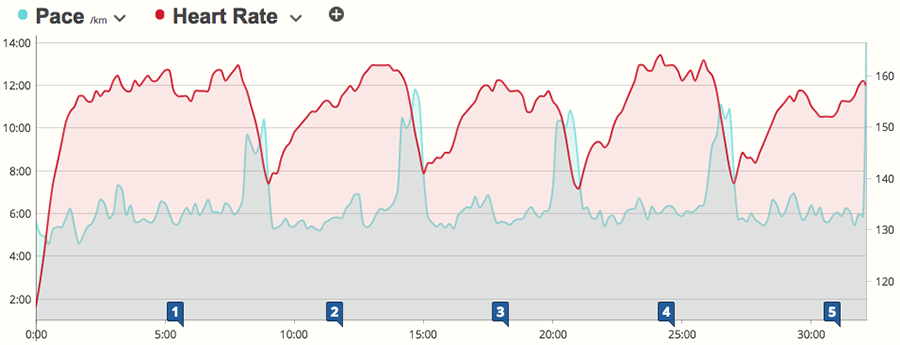How to Use Pace Zones
Now that you’ve got pace zones what are you gonna do with them?
We recently wrote about the basics of zone-based training, which introduces the concept of training with zones to complete beginners — so they can fully understand it. That post covers the fundamentals and shows you how to determine your current training zones so you could start using them right away. In this post, we dig deeper into pace zones, and explain how you can apply them to your training in a meaningful way.
You can find lots of information about heart rate and power zone training with a quick search on the web, but, if you’re curious about pace zones, information is more scarce. You can find out how to determine your pace zones, but it’s not clear what you’re supposed to do with them.

Why train with pace zones?
Pace zone training is very similar to heart rate training. Once you know your current threshold and zones, you can train to improve them, and target specific paces for intervals and other drills. If you don’t have access to a heart rate monitor, you can utilize pace zone training in its place. If you have one, you can mix up your training and keep things fresh by switching between heart rate and pace zone training, and combinations of the two.
To get started with pace zone training, you first need to determine your current zones (which is explained later in this article). Once you have that information, you can target your workouts to try to improve your efficiency at specific speeds, so you get faster. After four to six weeks of training at targeted paces, you can test your zones again, and see if you improved. At that point you can start training at your new threshold to see if you can improve yet again.
How do you determine your pace zones?
You determine your pace zones by running non-stop for 30 minutes on a flat course, going as fast as you can without slowing down. Your average pace from the entire 30 minutes will be your threshold pace. In order to determine your pace zones, you need to do some math, which is explained in this post (scroll down to the Running zones based on pace section). If you have a heart rate monitor, you should wear it during this test, as you will also be able to determine your LTHR from the final 20 minutes.
When I last conducted this test, my threshold pace was 5:55/km. Once I calculated my current pace zones, I went into my SportTracks account and updated the settings in my Training Options to match my new pace zones. Now when I do any running workout, I can look at the Analysis section of the workout details, select Pace, and see how much effort I applied in each zone. This is also useful for workouts where you're trying to target specific pace zones. You'll be able to see how effectively you hit your targeted zone. Nailing specific paces when you're out there pounding the ground is trickier than it sounds!

Pace zone training methods
How you decide to train with pace has a lot to do with your current physical state and your goals. You will have different needs if you're returning to running after an extended break, as opposed to someone who is more fit. Likewise, your needs will be different if you're training for a 5K, 10K, half-marathon, marathon, or multi-sport events.
That said, it's worthwhile to add pace zone training to your routine. Ultimately, everyone has a threshold, and doesn't hurt to train to improve it. The exact science behind threshold training is a bit fuzzy, but it's ultimately beneficial to add variety to your workouts, and pace zone training certainly accomplishes this.
Borrowing from the Jack Daniels’ school of thought, one of your tasks is to simply train at your threshold pace to see if you can improve it.
Training at threshold pace
Borrowing from the Jack Daniels’ school of thought, one of your tasks is to simply train at your threshold pace to see if you can improve it. Run right at, above, or just below your threshold pace for an extended period of time in an effort to increase it.
Some GPS watches have features that help you lock into specific pace zones. They alert you if you start running too slowly or too quickly, so you can maintain a specific pace for extended periods of time. If your watch or tracking device lacks specific pace zone features, it’s a simple matter of monitoring your pace as you run, so you stay in your targeted pace for as long as possible. The “real-time” pace feature on your device (which is often just called Pace) is the preferred metric you want to look at, as opposed to Average Pace or Lap Pace.
Your threshold pace is theoretically what you can sustain for one full hour in a race. The test to determine your threshold pace may only be 30 minutes long, but when you’re in the energetic atmosphere of a race, you typically can go longer and harder for greater lengths of time. Obviously, if you successfully train to increase your threshold pace, you will fare better in endurance races.
Interval training at threshold pace
Your threshold pace is at a high-exertion level (in my case it's in Zone 4). Training at high intensity levels for extended periods of time on a regular basis is taxing to your system, and the benefits of doing so are questionable. In order to effectively train in this zone, it's advisable to experiment with threshold pace interval workouts.

After a short warm-up run, start a series of five minute intervals at your threshold pace with one minute cool-down segments in between. Don't forget to hit the Lap button for each interval (both the cool-downs and the threshold pace segments). Completing five sets of these intervals is similar to an LTHR test, just with helpful one-minute breaks every five minutes. :) You can mix things up with intervals in the zones just below or above your threshold pace. As you get more fit, try extending the duration of the high-intensity segments, and shorten the length of the cool-downs.
I found it helpful to configure a specific data screen on my Garmin Forerunner watch for threshold pace interval workouts. I put the Timer in the top field, so I could keep track of my intervals, and also know the full duration of my run. In the middle field I put Pace, and in the bottom field I put Heart Rate, because I wear a chest strap HRM when I run. The next time I do one of these workouts, I may swap out Lap Pace for Pace in the middle field. The Pace metric was lagging a bit too far behind real-time. Seeing the average pace for the current lap would be more helpful.
Wrapping up
These are just a few ways that you can utilize your pace threshold and pace zones. If you work with a coach, they will likely schedule different drills in your training plan, depending on your ability level and the events you're training for. If you want more information about threshold pace training, check out the chapter on Training Runs and Intensities in the Daniels' Running Formula book.
| Article written by Sam Mallery, Director of Marketing, Zone Five Software Inc. |
